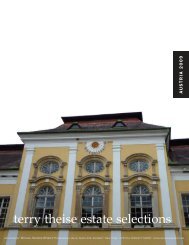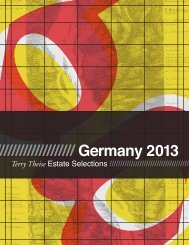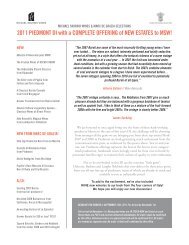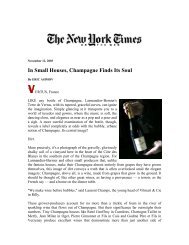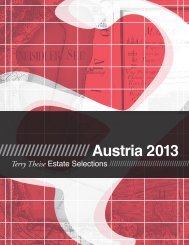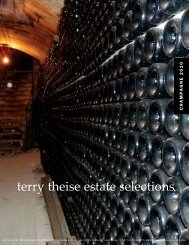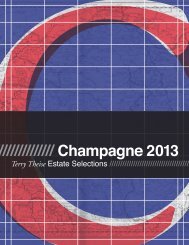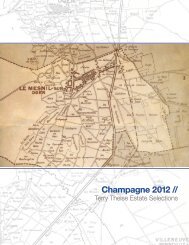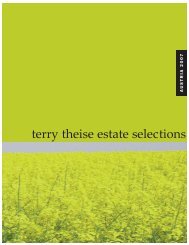German Catalog 2006 USE THIS ONE.qxp - Michael Skurnik Wines
German Catalog 2006 USE THIS ONE.qxp - Michael Skurnik Wines
German Catalog 2006 USE THIS ONE.qxp - Michael Skurnik Wines
You also want an ePaper? Increase the reach of your titles
YUMPU automatically turns print PDFs into web optimized ePapers that Google loves.
seems to have been born unable to speak except in rhetoric.<br />
What a character this was.<br />
His property may have been the last surviving example<br />
of an estate that combined viticulture and agriculture.<br />
It seemed to have frozen in time somewhere just after the<br />
War. Other growers would speak in pure bewilderment of<br />
Schneider’s antediluvian techniques: “It’s like an open air<br />
museum of how wine was made fifty years ago,” one<br />
grower said to me. No growers’ association meeting was<br />
complete without Hans Schneider. “If I looked around and<br />
didn’t see him, I’d try to leave undetected,” one guy told<br />
me. “The meetings were dull without him.”<br />
The young are indeed grabbing the reins now, but<br />
there is a legacy they carry even as they change and modernize<br />
it. I wonder if we Americans can really understand<br />
such a thing. So many of our basic human contexts—senses<br />
of time, of history, of continuity, family and<br />
community—lay in tatters. And we ourselves have<br />
shredded these things so we could get at other things we<br />
imagine we want. Can we actually see someone’s wines<br />
as representatives of a family legacy? Can we understand<br />
how wines become members of the family? It is<br />
sometimes obscure even for me, and I want to believe it.<br />
So I think of Schneiders, and how they render their<br />
wines, those strange songs of the earth who share the<br />
house with the family. There’s our world, all a-rush and<br />
full of clamor. Schneiders have a computer in the house<br />
now, and a satellite dish on their roof, and an email<br />
address. For all I know they watch more CNN than I do.<br />
I’m not into making them adorable peasants. I am just<br />
struggling to isolate a slippery little creature, that they<br />
seem fundamentally anchored and that we do not. And<br />
wine is part of what anchors them, or part of what they’re<br />
anchored to, or perhaps these are the same thing. And so<br />
it seems strange to dissect the wines as though they had<br />
no context in human life. It can’t be done.<br />
Thankfully the wines are lovely. I’d never have<br />
returned otherwise. But they are lovely in just such a<br />
way, such a particularly Schneidery way. They shouldn’t<br />
be served too cold, as it mutes the astonishing perfume<br />
that’s their raison d’être. Also, theirs is a self-contained<br />
world; the wines aren’t planned, nor are intended to be<br />
placed, in gigantic tastings with seventy-five other wines.<br />
Schneider is a perfect example of the impossibility of isolating<br />
wines from the people who make them. Yet every<br />
drinker doesn’t have the chance to go there and sit in the<br />
parlor and soak up the vibes, and so the wine must have<br />
something of value purely per se. Which harks back,<br />
again, to those aromas and flavors. If you can somehow<br />
drink a few of these at cellar temperature in circumstances<br />
permissive of reflection, I guarantee you’ll never<br />
be more enthralled by any other wines. Even wines I<br />
might agree are “better.” They are intensely poetic wines,<br />
but not necessarily lyric wines. They are elemental in<br />
some way; they have no time for frills or flourishes. They<br />
just exhale the earth.<br />
“Colorful” stories aside, these can be the most haunting-<br />
schneider at a glance:<br />
ly, intricately perfumed wines I have ever tasted. They<br />
are modernizing but still a fair way from modern; great wine-y depth in the best of them.<br />
This differs from site to site. The wines are less mealy<br />
how the wines taste:<br />
and more vigorous than they once were, more contemporary<br />
now. But you’d be well advised not to even try isolating any single consistent<br />
denominator from a village with 52 different soil types (!) That said, it’s clear these hail<br />
from great land.<br />
GJS-069L 2005 Niederhäuser Riesling Kabinett, 1.0 Liter<br />
This is THE sleeper-wine in this portfolio, like getting a by-the-glass priced big-format<br />
of Criots, Chevalier and Batard-Montrachet! So let’s see; which collection of Grand Crus<br />
make up this vintage’s Liter . . . ah, it’s merely Kirschheck, Klamm, and Kertz (hoo boy, a<br />
K-K-K wine; we should put white sheets and hoods on the bottles…oh ouch). But the<br />
wine shows, ah, grand wizardry . . . ? Well it does. There are extra fine aromas (three<br />
Grand Crus!), cherry-blossom and boucherie; the palate is just superb, with endless elegance<br />
and charm, wonderful backbone and length.<br />
SOS: 2 (now to 8 years)<br />
109<br />
NAHE WINES



